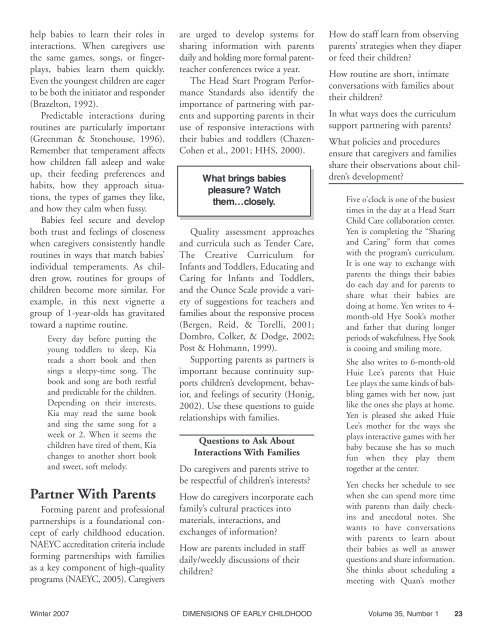Dimensions of Early Childhood - Southern Early Childhood ...
Dimensions of Early Childhood - Southern Early Childhood ...
Dimensions of Early Childhood - Southern Early Childhood ...
Create successful ePaper yourself
Turn your PDF publications into a flip-book with our unique Google optimized e-Paper software.
help babies to learn their roles in<br />
interactions. When caregivers use<br />
the same games, songs, or fingerplays,<br />
babies learn them quickly.<br />
Even the youngest children are eager<br />
to be both the initiator and responder<br />
(Brazelton, 1992).<br />
Predictable interactions during<br />
routines are particularly important<br />
(Greenman & Stonehouse, 1996).<br />
Remember that temperament affects<br />
how children fall asleep and wake<br />
up, their feeding preferences and<br />
habits, how they approach situations,<br />
the types <strong>of</strong> games they like,<br />
and how they calm when fussy.<br />
Babies feel secure and develop<br />
both trust and feelings <strong>of</strong> closeness<br />
when caregivers consistently handle<br />
routines in ways that match babies’<br />
individual temperaments. As children<br />
grow, routines for groups <strong>of</strong><br />
children become more similar. For<br />
example, in this next vignette a<br />
group <strong>of</strong> 1-year-olds has gravitated<br />
toward a naptime routine.<br />
Every day before putting the<br />
young toddlers to sleep, Kia<br />
reads a short book and then<br />
sings a sleepy-time song. The<br />
book and song are both restful<br />
and predictable for the children.<br />
Depending on their interests,<br />
Kia may read the same book<br />
and sing the same song for a<br />
week or 2. When it seems the<br />
children have tired <strong>of</strong> them, Kia<br />
changes to another short book<br />
and sweet, s<strong>of</strong>t melody.<br />
Partner With Parents<br />
Forming parent and pr<strong>of</strong>essional<br />
partnerships is a foundational concept<br />
<strong>of</strong> early childhood education.<br />
NAEYC accreditation criteria include<br />
forming partnerships with families<br />
as a key component <strong>of</strong> high-quality<br />
programs (NAEYC, 2005). Caregivers<br />
are urged to develop systems for<br />
sharing information with parents<br />
daily and holding more formal parentteacher<br />
conferences twice a year.<br />
The Head Start Program Performance<br />
Standards also identify the<br />
importance <strong>of</strong> partnering with parents<br />
and supporting parents in their<br />
use <strong>of</strong> responsive interactions with<br />
their babies and toddlers (Chazen-<br />
Cohen et al., 2001; HHS, 2000).<br />
What brings babies<br />
pleasure? Watch<br />
them…closely.<br />
Quality assessment approaches<br />
and curricula such as Tender Care,<br />
The Creative Curriculum for<br />
Infants and Toddlers, Educating and<br />
Caring for Infants and Toddlers,<br />
and the Ounce Scale provide a variety<br />
<strong>of</strong> suggestions for teachers and<br />
families about the responsive process<br />
(Bergen, Reid, & Torelli, 2001;<br />
Dombro, Colker, & Dodge, 2002;<br />
Post & Hohmann, 1999).<br />
Supporting parents as partners is<br />
important because continuity supports<br />
children’s development, behavior,<br />
and feelings <strong>of</strong> security (Honig,<br />
2002). Use these questions to guide<br />
relationships with families.<br />
Questions to Ask About<br />
Interactions With Families<br />
Do caregivers and parents strive to<br />
be respectful <strong>of</strong> children’s interests?<br />
How do caregivers incorporate each<br />
family’s cultural practices into<br />
materials, interactions, and<br />
exchanges <strong>of</strong> information?<br />
How are parents included in staff<br />
daily/weekly discussions <strong>of</strong> their<br />
children?<br />
How do staff learn from observing<br />
parents’ strategies when they diaper<br />
or feed their children?<br />
How routine are short, intimate<br />
conversations with families about<br />
their children?<br />
In what ways does the curriculum<br />
support partnering with parents?<br />
What policies and procedures<br />
ensure that caregivers and families<br />
share their observations about children’s<br />
development?<br />
Five o’clock is one <strong>of</strong> the busiest<br />
times in the day at a Head Start<br />
Child Care collaboration center.<br />
Yen is completing the “Sharing<br />
and Caring” form that comes<br />
with the program’s curriculum.<br />
It is one way to exchange with<br />
parents the things their babies<br />
do each day and for parents to<br />
share what their babies are<br />
doing at home. Yen writes to 4-<br />
month-old Hye Sook’s mother<br />
and father that during longer<br />
periods <strong>of</strong> wakefulness, Hye Sook<br />
is cooing and smiling more.<br />
She also writes to 6-month-old<br />
Huie Lee’s parents that Huie<br />
Lee plays the same kinds <strong>of</strong> babbling<br />
games with her now, just<br />
like the ones she plays at home.<br />
Yen is pleased she asked Huie<br />
Lee’s mother for the ways she<br />
plays interactive games with her<br />
baby because she has so much<br />
fun when they play them<br />
together at the center.<br />
Yen checks her schedule to see<br />
when she can spend more time<br />
with parents than daily checkins<br />
and anecdotal notes. She<br />
wants to have conversations<br />
with parents to learn about<br />
their babies as well as answer<br />
questions and share information.<br />
She thinks about scheduling a<br />
meeting with Quan’s mother<br />
Winter 2007 DIMENSIONS OF EARLY CHILDHOOD Volume 35, Number 1 23

















